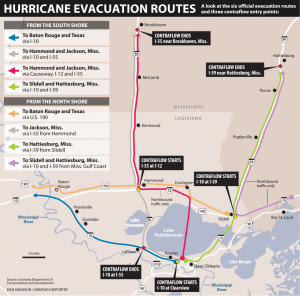HURRICANE INFORMATION BELOW
Hurricane Preparedness Tips
Important steps toward saving lives and property:
- The time to prepare is before the storm.
- Assemble a disaster supply kit to include water, nonperishable food items, first aid supplies, clothing & bedding, tools & emergency supplies, and any special items like prescribed medicine.
- Clear loose and clogged rain gutters and downspouts. Trim trees and shrubbery.
- Review your insurance policy and gather your important documents incase of evacuation.
Hurricane Safety Tips:
- Fuel up and service your vehicle.
- Secure all windows and any items that could become flying objects.
- Wedge sliding glass doors so they do not lift off track.
- Have flashlights with extra batteries and a first aid kit available.
- Turn refrigerator to the coldest setting in case of power failure.
- Have an extra supply of cash on hand.
- Protect pets.
- Evacuate if advised to do so!
If you evacuate:
-
Leave during daylight, if possible.
-
Notify neighbors and one family member outside of the affected area.
-
Monitor local TV and radio for official bulletins: NOAA Weather Radio 162.400
Your Local School System:
In the event of a major hurricane or any other emergency, the superintendent, in consultation with parish emergency management officials, will make the final determination on school closures.
For more information contact your local school system.
Shelters:
In the event of a major storm, shelters will be opened and maintained by volunteers of the American Red Cross.
What to bring to a shelter:
- Blankets, sleeping bags, and pillows
- Medications: insulin, heart, and others
- Baby food and diapers
- Plastic container of water, sandwiches, and snacks
- Flashlight, radio, and extra batteries
- First Aid Kit
- Identification, cash, and valuable papers
Pets are not allowed in shelters.
To find out the location of the nearest shelter contact your local Office of Emergency Preparedness or local authorities.
For information on sheltering contact your local American Red Cross Office.
Flooding:
The most common type of all natural hazards is flooding. Prepare a disaster supply kit and listen to radio and TV stations for the most current information.
- Maintain and inspect vehicles regularly to ensure safe and reliable operation.
- Equip vehicles with serviceable emergency items such as spare tires, jacks, lug wrenches, lighting, flares, tie-downs, extra fuel, necessary tools, etc.
- Learn alternate evacuation routes and utilize them early to avoid dangerous conditions, congestion, and denied access to certain highways.
- Place maps or your local area, and the areas you are traveling in, to reference alternate routes.
- Keep and maintain a disaster supply kit in your vehicle.
- Don’t attempt to drive around barricades, even if the roadway appears safe.
Recreational/Special Use Vehicles:
During emergency evacuation procedures boat trailers, horse trailers, motor homes, motorcycles, and similar special use vehicles pose unique problems which can be avoided by advance planning and preparation. It is important to consider that not only may these vehicles be difficult to maneuver in congested traffic conditions, but that evacuation routes over bridges, elevated roadways, and flat unbroken terrain will be subject to high winds that will make movement there potentially hazardous to such vehicles. In fact, it is probable that after actual evacuation procedures are underway, public safety officials will deny access to affected bridges and highways by these types of vehicles.
During emergency evacuation procedures boat trailers, horse trailers, motor homes, motorcycles, and similar special use vehicles pose unique problems which can be avoided by advance planning and preparation. It is important to consider that not only may these vehicles be difficult to maneuver in congested traffic conditions, but that evacuation routes over bridges, elevated roadways, and flat unbroken terrain will be subject to high winds that will make movement there potentially hazardous to such vehicles. In fact, it is probable that after actual evacuation procedures are underway, public safety officials will deny access to affected bridges and highways by these types of vehicles.
Consequently, the following tips are offered to citizens wishing to remove special use vehicles from harm’s way. This list is not intended to be all-inclusive; citizens are directed to contact local or State Police and emergency management offices for timely and detailed instructions pertinent to specific incidents. And, as always in emergency conditions, common sense and sound judgment must prevail.
- Identify in advance an adequate storage location at minimum safe distance.
- Learn alternate evacuation routes and utilize them early to avoid dangerous conditions, congestion, and denied access to certain highways.
- Move vehicles before the official evacuation begins, if at all possible.
- Maintain and inspect vehicles regularly to ensure safe and reliable operation.
- Equip vehicles with serviceable emergency items such as spare tires, jacks, lug wrenches, lighting, flares, tie-downs, extra fuel, necessary tools, etc.
- Remember! Property considerations are secondary to the health and safety of human lives.
The key to success is advanced planning, preparation, and movement of property BEFORE an officially-declared evacuation is underway.
State and National Hurricane Information Site Links
City and State sites:
Weather Information sites:
To obtain your own paper copy of the Louisiana Citizen Awareness and Disaster Evacuation Guide, please contact your local chapter of the American Red Cross.
SOUTHEAST LOUISIANA
Greater New Orleans Area: 1-800-229-8191 or 504-620-3105
St. Bernard Parish: 504-278-4228
SOUTHWEST LOUISIANA
Lafayette Area: 337-234-7371
Lake Charles Area: 337-478-5122

